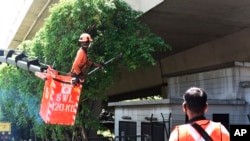It’s a side of Singapore not often seen: Colorful T-shirts hang from the bunks, or from rods attached to the beds as makeshift closets. The taupe colored walls of the dorm room are bare, except for the occasional fan jutting out.
But the foreign workers’ dorms are coming into the spotlight as COVID-19 surges among their residents, forcing Singapore to bring back restrictions it thought had already stemmed the spread of the disease. The latest wave of infections, mostly among migrant workers, highlights how Singapore ricocheted from a seeming success case to having the most infections in Southeast Asia.
Out of 18,778 virus cases reported by Monday, 16,393 came from workers living in dorms, according to the Singapore Ministry of Health. The workers are part of the island’s two-track economy, which attracts British traders and bankers, as well as Philippine cleaners and Bangladeshi construction workers. The latter tend to reside in dorms, bunking up to 20 people a room. “Transient Workers Count Too,” an advocacy group, said it had been warning that this crowding posed a risk for viral spread.
“There’s no denying now that density and poor ventilation in our dorms are key factors enabling pathogen transmission,” said Alex Au, the vice president of the organization.
However he said that the dorms are just a symptom of a broader issue.
“I would point out that Singapore has an addiction to cheap labor,” he said in a webinar. “We have an economic model that is reliant on them for our prosperity.”
Migrant workers are in the spotlight now because they account for the vast majority of new COVID-19 cases in Singapore, a nation better known for gleaming towers and “crazy rich” Asians than manual labor.
Before then, the focus had been on the rapid response of the technocratic government, dominated by a single party. Singapore was hailed alongside states like South Korea and Taiwan because it quickly treated patients, contact traced, and cut off foreign travel.
But travel restrictions wouldn’t address domestic transmission of COVID-19, which Prime Minister Lee Hsien Loong said was “hidden” as it spread, particularly among laborers. Daily cases have passed 1,000 multiple times in the past three weeks, versus a few hundred before that.
Singapore’s case load of 18,778 is the highest in Southeast Asia, yet it has the smallest population in the region except for Brunei. More than one in five people in Singapore are foreign workers.
“The COVID-19 pandemic has shown that migrant workers are indispensable to the functioning of our country,” HOME, a nonprofit that helps workers with living conditions, wage theft, and employer abuse, said in a statement. “We need to make it possible for them to advocate for their own well-being and for them to speak up without fear of persecution.”
Manpower Minister Josephine Teo said there is “no question” in her mind that Singapore should improve dorm conditions. In the short term her ministry is coordinating food distribution and overseeing managers who increase the cleaning of dorms. However she said the nation must overcome the virus emergency before it can address workers’ living conditions “in a dedicated way” in the long term.
The Health Ministry also said it is increasing testing in the dorms, contact tracing, and surveillance.
“In preparation for the expected increase in the number of cases, especially from the dormitories, we have rapidly expanded our healthcare capacity,” Health Minister Gan Kim Yong said Monday. “This includes both medical facilities, as well as healthcare manpower.”
Part of the challenge for Singapore is the fraction of cases that are “unlinked,” meaning authorities can’t determine how the virus spread from one person to another. That's why the prime minister warned of a "hidden reservoir" of virus cases in the community.
Beyond the pandemic, Au, the worker advocate, hopes this will be a teachable moment for Singapore to address broader issues, such as exorbitant recruiter fees and unpaid overtime for migrant workers.
Labor inequities are part of a “structural problem” that leaves the nation vulnerable, Au said, adding, “It’s hard to predict where the next crisis might come from.”




